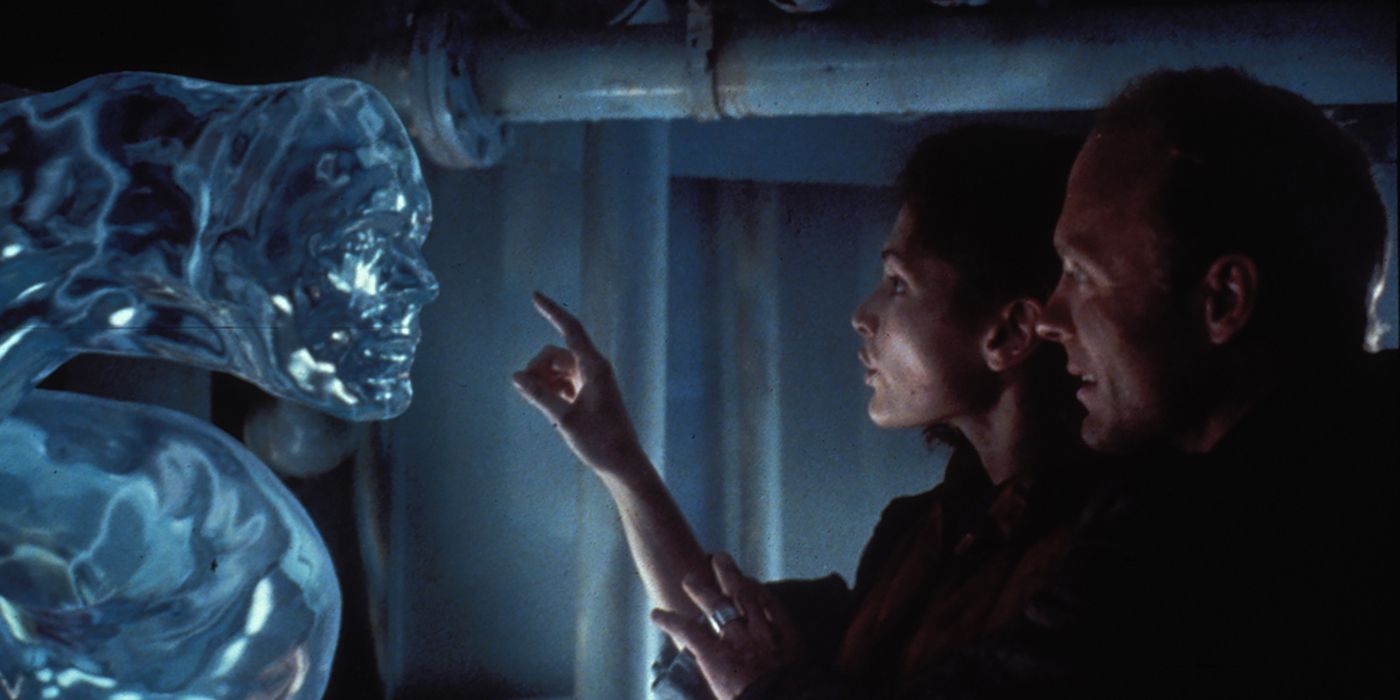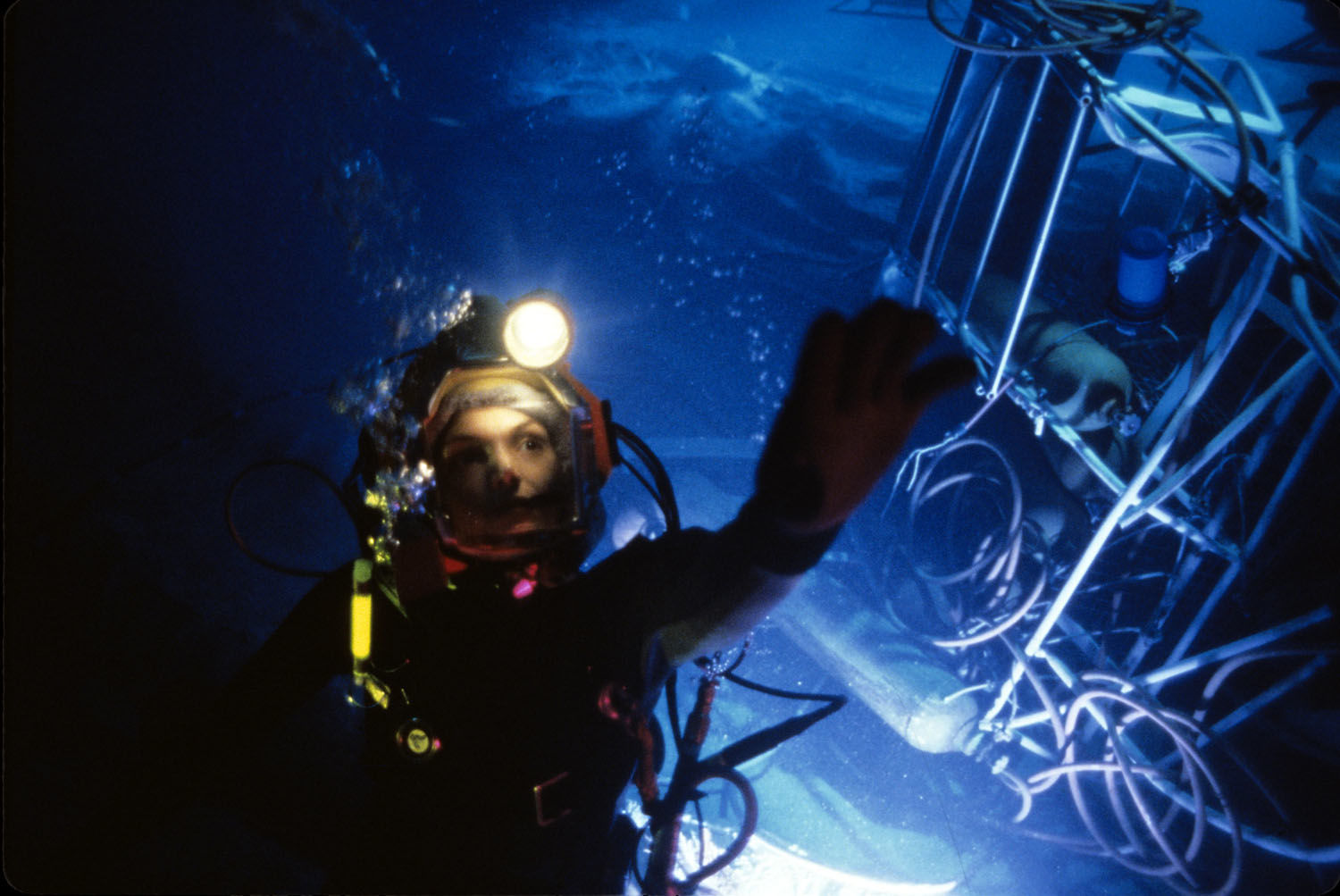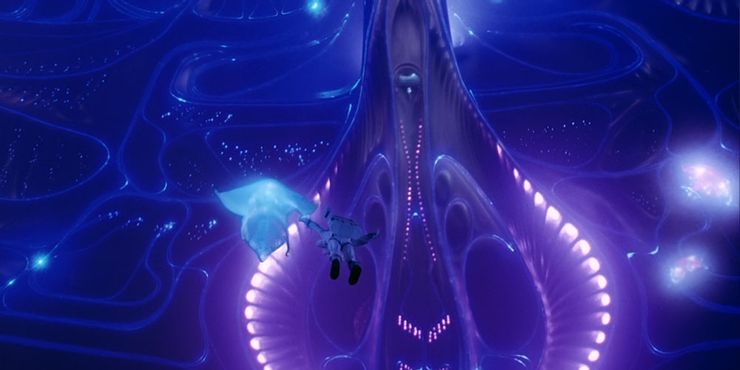After hearing a biology lesson about a deep-sea diver in high school, James Cameron began writing The Abyss tale. Stories of deep-sea research and the possibility of liquid breathing captivated him. Cameron’s passion for the sea is evident in his films Titanic and the Abyss. He is even commissioned a couple of underwater documentaries, one of which is about the making of his movie.
The special effects in the picture are still considered exceptional to this day, and most of the filmmaking technology was invented specifically to record the actors’ dialogue while they were underwater.
Even the helmets were custom-made to reveal the performers’ faces. The Abyss is one of the most challenging pictures to make for a variety of reasons, yet it is also one of James Cameron’s most underappreciated. In fact, it was his only film that did not debut at the top of the box office. Perhaps because there were a lot of underwater movies made in 1989, and two of them were already in theaters when Abyss came out.
The picture has earned the respect it deserves throughout the years, and it is unquestionably one of the best underwater films ever made. Today, we will delve into The Abyss and learn about the NTIs, or Underwater Floating Objects, that inhabit our planet’s deep oceans.
The Abyss – one of the most difficult films to be ever made

A submarine crew discovers signals coming from an unidentified ship approaching. The submarine collides with the unidentified object before they can launch an attack to defend themselves. The wires begin to malfunction and seawater floods the cabins because of the damage caused by the collision.
A team of Navy Seals along with Lindsey arrive to examine the wreckage, but no one seems to be thrilled to see her. The Benthic ship makes contact with Deepcore to ask for their co-operation in a matter of national security.
Bud, who’s in charge of the Deepcore, and Lindsey were in the middle of their divorce proceedings, and having to work together once again brought in awkwardness not only amongst themselves but also for those around them.
The writer and director James Cameron himself was in the middle of having his divorce finalized with his then-wife Gale Anne Hurd, who was also a producer for The Abyss. Previously, they had worked together on the Terminator and Aliens and Lindsey’s character was inspired by his ex-wife.
Although it doesn’t count as autobiographical, Lindsey and Bud’s situation was similar to his own. The two hadn’t fallen out of love with each other but knowing neither could make their relationship work added more tension between the two characters. The ship that had drowned was an American Nuclear Submarine and had over 150 men on board.
They wanted the help of the Deepcore crew as they required deep-sea divers to salvage the wreck and find out if anyone had survived. The crew’s expertise lay in oil mining but the promise of triple the paycheque was enough to get them to cooperate, despite their skepticism about the mission.
Because of Hurricane Frederick approaching on the surface, the team of deep-sea divers, under the leadership of Lieutenant Coffey, was their best option for the rescue operation. Cameron has quite the reputation in Hollywood because of being a perfectionist, and the cast and crew were required to train for two weeks to become certified divers before they started shooting.
The actors who played navy SEALS had to receive military training and it is to be noted that The Abyss is one of the few underwater action films to not use stuntmen or body doubles in most of the scenes.
Lindsey wasn’t thrilled at the idea of working with her estranged husband and she was pissed off as it interfered with her work. She was very close to proving the submersible drilling platform as functional as she was the chief engineer who built the Deepcore. Lindsey arrives at Deepcore with the team of SEALS and they closely check each other for signs of High-Pressure Nervous Syndrome.
After spending eight hours underwater, 1 out of 20 people show symptoms of HPNS. When one dives under 150 meters with breathing helium-oxygen gas mixtures, they might end up suffering from neurological, psychological, and electroencephalographic abnormalities.
The severity of the clinical presentation depends on the speed of compression and the hydrostatic pressure attained.
While the other SEALS seemed fine, Lieutenant Coffey had begun to show symptoms of HPNS and developed a hand tremor. Meanwhile, on the other side of the ship, Lindsey and Virgil, also known as Bud, were under the same ship after a long time. While Lindsey hid behind the pretense of worrying about the rig, Bud was clearly happy to see her. But not everyone aboard shared his sentiments, especially Lisa.
While Lindsey had already tried to move on from her failed marriage, Bud was still wearing his wedding ring as the divorce hadn’t been finalized yet, and for him, that held enough glimmer of hope.
He clearly didn’t want to give up on the relationship yet, otherwise, he wouldn’t have gone back to retrieve his wedding ring from the toilet after throwing it in there. Lieutenant Coffey treated the Deepcore crew the same way as he would treat those under his command and expected them to follow orders without asking any questions.
Bud preferred a different method of leadership when it came to his crew but Coffey wasn’t open to communication. While the rest of the crew geared up for the expedition, a SEAL member snatched Hippy’s rat to demonstrate the technology of breathing liquid.
The infamous scene included him drowning the little rat in the pink liquid as it adjusted itself to the new setting. Initially, the rat went into shock and struggled for a bit but then it began to inhale the breathing liquid.
The liquid in question was oxygenated fluorocarbon, a technique pioneered by Dr. Johannes Kylstra and Dr. Peter Bennet of Duke University. They worked as consultants on the film and were very much involved in the process of preparing the liquid.
Thankfully, the rat was never in danger of dying but it did cause enough distress for it to defecate in the liquid. Hence, the camera cut away from the actor’s faces as it wasn’t a pretty scene.
The crew and the seals dive into the nuclear reactor, only to find floating corpses and enough nuclear weapons to cause World War III. The sight of spiders crawling out of one of the corpses makes Jammer squeamish but decides to carry on with the operation. After his rope comes untied, he spots a source of radiating light underneath. At first, he thinks it’s Bud but as the source of light gets near him, he begins to convulse and slips into a coma. The other underwater movies at that time were usually shot under the ocean, but that wasn’t the case with the Abyss.
A half-completed nuclear reactor tank was filled with 7.5 million gallons of water, and the surface was filled with plastic beads to keep the light from getting in. As sunlight doesn’t get in the depth of the ocean the story is set in, a large tarpaulin was used to cover the surface. But that was hardly a permanent solution as the tarpaulin and the beads got blown up during a storm.
After that Cameron could shoot the scenes underwater only after sundown. Jammer wasn’t the only one to see a floating source of light underwater, Lindsey saw it as well but she couldn’t film or photograph it as she had run out of power. Coffey assumed it to be a Russian attack sub and reported it to the officer in charge.
The Cold War between the USA and Russia was still brewing at the time and the severity of finding a Russian sub near the American coastline was definitely not good news probably as potentially lethal as the Cuban Missile Crisis could’ve been had it not been contained in time. As Coffey was worried about national security, he took his Navy Seals in Deepcore’s mini-sub without consulting the crew and dived down to extract one of the tridents from the nuclear reactor.
Non-Terrestrial Intelligence a.k.a Underwater Floating Objects Inhabiting The Ocean Depths Of Planet Earth – Explored

When Lindsey had come across the unidentified source of light the first time, she was unable to document it as she had run out of power. She comes across them once again while she went under Montana to investigate the rig. She begins to lose communications with the Deepcore due to power failure.
And when she was having trouble with her light, the unidentified source of light floated up behind her. That’s the first time Lindsey witnesses the creature in all its glory. The creature appears like a jellyfish that can take on the shape and form of anything including a submarine. It glows pink and blue and doesn’t appear to be malicious in nature.
Lindsey was so fascinated by the sight in front of her that she couldn’t resist touching the creature. Unlike last time, she managed to capture the creature on film. After getting back on the Deepcore, she explains to the crew that what she encountered was non-human but intelligent.
She termed the creature as a Non-Terrestrial Intelligence, which was shortened to NTI by Hippie. For a long time, extraterrestrial or non-terrestrial beings only existed in science fiction but NASA has recently accepted that we are not alone in the universe.
The solar systems of Epsilon Eridani and Tau Ceti, located 11 light-years away are more likely to inhabit extraterrestrial beings than Alpha Centauri, according to Dr. Su-Shu Huang of NASA as the planetary system of the layer is too young to inhabit life.
Our nearest neighbors are possibly 100 light-years away and it would take 200 years to communicate with them. But it would be safe to assume that the other civilizations would be far more advanced than ourselves. Even Stephen Hawking warned about the advanced alien civilizations who might colonize the planets they reach. But the NTI in The Abyss wasn’t hostile and didn’t show any desire to colonize the planet. But Coffey thinks of them as Russian Subs. Lindsey was certain that the NTIs didn’t mean any harm and she described them to Bud as a dance of light that glides, and as a machine that’s alive.
Their technology was far superior to ours and their machines weren’t built of steel and iron. One night, the NTI sneaks in through the pool of Deepcore and takes the form of a water tentacle.
It appears like a snake and slithers in every compartment. While the rest of the crew was asleep, Lindsey was the first to notice the water tentacle looking at them. Bud woke up the rest of the crew and all of them were awestruck by the sight before them. As the water tentacle took the form of Lindsey’s face and imitated her expressions, she concluded that the NTI was trying to communicate with them.
The NTI leads them to the room with a nuclear missile, but before it could communicate further, Coffey freaks out at the sight of the tentacle and closes the doors, causing the tentacle to lose its control over water and splash down on the floors. This particular scene was written in a way that it could be taken out without affecting the rest of the story.
The CGI technology attempted for this scene was almost non-existent at that time. So Cameron filmed this scene early to give the CGI team enough time to bring his vision to life. At that time Cameron didn’t know if the CGI team would be able to pull it off, and he wanted to remove the scene altogether if the visual effects didn’t meet his expectations.
Lindsey theorized that the NTIS had learned how to control water at a molecular level, and they can do whatever they want to do with water including pulverizing or plasticizing it. Their whole technology is based on controlling water.
One of the crew members thinks that what Lindsey saw underwater was different from the water tentacle. Perhaps, the source of dancing light was their version of ROV, like the big geek. Coffey’s HPNS had begun to get the best of him worsening his mental state as he was growing paranoid by the second.
His symptoms got so severe that he started to slit his wrist and locked in the crew as he took all the ammunition and headed to bomb the NTI. He thought the others were being naive about the dangers the NTI could subject them to, as the first thing the water tentacle led them to was the nuclear missile.
The crew was worried that his actions could lead to a full-blown extraterrestrial war. In order to reverse the danger Coffey was about to put the planet in, Bud had to take on a life-threatening mission to save the NTIs as well as the planet.
The extended cut of the film includes a scene where the NTIs communicate with Bud by showing him the footage of the wars the planet has witnessed and they had almost made up their mind to put a stop to the warmongering nature of the planet by drowning it. But they had changed their minds after seeing the text Bud had sent to Lindsey, as he knew of the risk he was taking but he wanted to save everyone anyway.
The NTIs from the abyss wasn’t the only good aliens in Hollywood history. It would be criminal to forget about ET who befriended Elliot. Speaking of Aliens who didn’t declare a war on our planet, we have to consider the Man of Steel, who had put in a lot of effort to save us from the villains of Earth as well as Krypton.
The NTIs never posed any danger to Earth but they are very much capable of flooding the entire planet if they wanted to. And they did judge the earthlings based on decade-old news clips and concluded that human beings are too self-destructive. But they weren’t rigid in their stance and changed their mind after witnessing the compassion humans harbor for each other, especially Bud and Lindsey.
Although it is not clear which galaxy the NTIs arrived from, it’s safe to assume they come from a marine civilization. The earthlings probably didn’t notice them arriving in a spaceship as they might have directly landed and settled at the bottom of the ocean.
Why should you watch The Abyss?

The underwater movies that were released in 1989 barely hold a candle to The Abyss in terms of visual effects and storytelling. The main characters of the story are so well developed that you notice they are polar opposites but still hope that they can make their failed relationship work. Even though Coffey isn’t a villain in the traditional sense, you cannot help but chide his actions while also understanding where his paranoia comes from.
The Abyss was one of the hardest films to make and Cameron has pushed his creative boundaries as well as his actors to bring out the absolute best in them. The filming process was so strenuous for the cast and crew that the actors begin to refer to the film as the abuse, son of abyss and life’s abyss and then you dive.
To date, Ed Harris refuses to talk about his experience on set and Mary Elizabeth Mastrantonio reportedly had a breakdown on set because of how far she was pushed. During the scene where Bud has to float with Lindsey’s body, she didn’t use a stunt double and required the actress to hold her breath.
The scene where the crew is trying to revive her and Bud slaps her to bring her back to life required multiple takes and it was too strenuous for Mastrantonio. The actors weren’t the only ones under pressure, Cameron himself had almost drowned and got back to shooting an hour later.
Because of the Leviathan and DeepStar Six releasing before The Abyss, people expected another underwater horror and found the ending and the nature of the aliens quite anti-climactic. The Abyss is clearly a science fiction thriller set underwater and the conflict focuses on human relationships rather than the threat of a volatile extraterrestrial creature. It’s sad that the movie hasn’t been released on Blu-ray yet.
One needs to watch the Abyss to see how they used CGI so intricately when the technology was relatively new and the amount of hard work the cast and crew have put in to bring Cameron’s vision to the screen.
